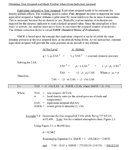The first delivery of the P-47N was September, 1944
My comments are about the P47M.
It seems that 47M was grounded twice, a couple days in late Feb and from 16th to 24th March 45.
During the operational trials in Feb it was grounded, yes.
Don't confuse operational trials with operational service, however.
In operational service it was again grounded in March. The mission was flown on 04 March 45 as I understand it. The CO of the 56th FS grounded the type and reverted back to their D models which were still on the flight line.
AFAIK, It was grounded because the aircraft was unreliable and was maintaining an average of a 50% abort rate in the squadron.
This would have generated paperwork officially grounding the type and requesting the technical resources to address the problem and get the type ungrounded. I have no doubts those dates originate from such paperwork.
You are free to have your own opinion on this too.
As a pilot, IMHO, this is a really silly argument. The aircraft was not ready for service and had some serious difficulties due to its fuel. While it might seem really peachy to have such an aircraft when you just hit the reset button, a real pilot is risking death a large percentage of the time. He is gambling that he can make it safely to the ground in a machine that has a very good chance of not working properly. There was good reason to ground it and the operational trials were due to end in March. AFAIK, they did end in March after the grounding in February and Pratt and Whitney's assurances the type would be reliable.
It did not work out that way and the type was again grounded in March.
Somewhere between the G-6 and K, 800 lbs was lost.
Several designs experienced this over their lifecycle. Look at the La series in service with the VVS. It does not mean they are "stripped down". Many times just changing a designs dimpling can have a large benefit in weight savings.
Be careful when reading specific engine charts if you do not understand what you are doing. Just warming up, the R-2800 requires 45 gallons of fuel and the P47 has 33 gallons of unusable fuel on board. Some range estimates do not include a reserve while others list a radius.
Make sure too that the engine is capable of operating at its maximum range settings at the altitude under discussion.
Range data is also listed for a specific altitude in many cases. The range will change based on altitude!
I don't care to argue with game sim fans about when or where their favorite aircraft came into service or how much better it was than all the other game shapes. It's not my cup of tea.
All the best,
Crumpp


